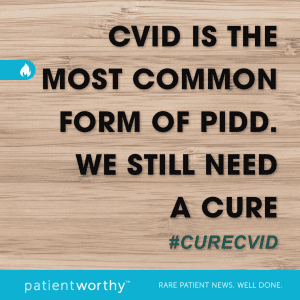There are 250+ PI Disorders Out There

Primary immunodeficiency disorders were once shrouded in misinformation and a general lack of understanding. Many would argue that this is still true today (because it is), but much has changed over the last 60 years.
Since Primary Immunodeficiency (PI) is a term that applies to more than 250 disorders that are recognized by the World Health Organization, both pre and post diagnosis can certainly be a challenging time.
Patient Worthy continues to cover more and more PIs, and we are always on the lookout for
PI’s are classified into 3 main specific disease types:
- Antibody Deficiencies
- Cellular Immunodeficiencies
- Innate Immune Disorders
Of these 3 types, hundreds of diseases like Common Variable Immune Deficiency (CVID), Severe Combined Immune Deficiency and Combined Immune Deficiency, Chronic Granulomatous Disease, and Other Phagocytic Cell Disorders fall on the docket of genetic (inherited) diseases, and they can affect anyone, regardless of age or gender.
The good news is that organizations like Patient Worthy, The Immune Deficiency Foundation and the Primary Immunodeficiency Association (who has since lost funding and has most unfortunately been closed) are a great start to help patients, caregivers and advocates alike, sort through the maze of information that is available.
Here is some Practical Information about Primary Immunodeficiency Disorders:
1. Be Proactive
No one knows you better than you so you should be proactive in advocating for yourself and what is going on. With the resources now available, you do not have to flounder around in the dark when you are dealing with your particular immune system disorder.
2. Everyone Is Different
The only common denominator in regards to living with a PI is that it is from a defect in one of the functions of the body’s normal immune system. Just like snowflakes and fingerprints, no two people who suffer from a PI disorder are the same. Not all patients will have the same symptoms. In fact, a combination of symptoms differs from one person to the next, and many external and internal factors affect the severity and frequency of infections.
Some of the More Common Symptoms
- Bone infections — Can affect the feet and hands, but also involve the ribs and spine.
- Joint infections.
- Persistent diarrhea — Between 40 percent and 50 percent of those with a PI develop intestinal inflammation that does not point to a specific infection. Since this symptom can be mistaken for Crohn’s disease and responds to many of the same treatments, it often takes time to get the correct diagnosis.
- Frequent and difficult-to-clear skin infections.
- Pneumonia — (CGD patients particularly) are susceptible to fungal pneumonia. Symptoms for this type of pneumonia are slow to develop, with prolonged fatigue appearing long before coughs or chest pain.
3. Great Advances Have Been Made
The past half-century has seen great improvements in the quality of life for those with Primary immunodeficiency disorders. In the 1950s, CGD was considered a fatal disorder for children and the aged. Today, survival and thrival is not only possible, but probable with early detection, a great HCP team, a positive attitude, and proper care.
Share this PI information today!
 Check out some of our Contributor stories about life with a PI.
Check out some of our Contributor stories about life with a PI.
This is What Staring CVID in the Face and Kneeing it in the Groin Looks Like
CGD is No Match For This Mighty Little Hero






